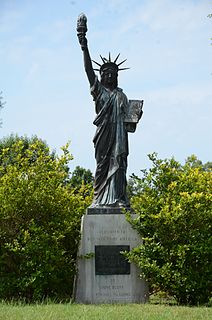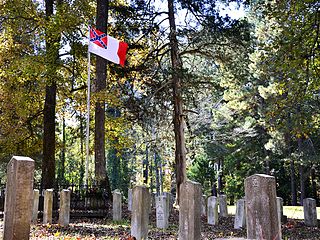
The University of Arkansas at Pine Bluff (UAPB) is a public historically black university in Pine Bluff, Arkansas. Founded in 1873, it is the second oldest public institution in the state of Arkansas. UAPB is part of the University of Arkansas System and Thurgood Marshall College Fund.

Marks' Mills Battleground State Park is an Arkansas State Park located at the junction of Arkansas Highway 8 and Arkansas Highway 97, north of New Edinburg, Arkansas. It preserves a portion of the battlefield of the Battle of Marks' Mills fought on April 25, 1864, in the Trans-Mississippi Theater of American Civil War. The battle was part of the Camden Expedition. The park is one of nine historic sites that make up the Camden Expedition Sites, a National Historic Landmark District.

The McDonald's Sign, also known as McDonald's Store #433 Sign, in Pine Bluff, Arkansas, United States, is one of only two surviving examples of a single-arch McDonald's sign. The sign was erected in 1962 and remained at its original location until 2007. That year, McDonald's Store #433 moved and the sign was renovated and moved to the new location. The McDonald's sign was added to the U.S. National Register of Historic Places in 2006.

The Strengthen the Arm of Liberty Monument is a replica of the Statue of Liberty in Pine Bluff Memorial Gardens, on the south side of 10th Avenue between Georgia and State Street in Pine Bluff, Arkansas. It was placed by the Boy Scouts of America (BSA) as part of its 1950s era campaign, "Strengthen the Arm of Liberty." The statue is 8 feet (2.4 m) in height, made of copper, and is mounted on concrete base 3.5 feet (1.1 m) tall. The statue faces north, toward the Pine Bluff Civic Center, and there is a bronze commemorative plaque on the north face of the base. It is one of two BSA-placed statues in the state; the other is in Fayetteville.

Highway 190 is a designation for four state highways in Arkansas. Three are low-traffic rural highways in Grant County, with one designation along city streets in Pine Bluff. The rural segments were created in 1965 and 1966, with the Pine Bluff section created in 2000 as a renumbering of Highway 104. All segments are maintained by the Arkansas Department of Transportation (ARDOT).

The Camp White Sulphur Springs Confederate Cemetery is an American Civil War cemetery in Arkansas. It is located northeast of the village of Sulphur Springs, also known as White Sulphur Springs, in Jefferson County.

Union Station is a former railroad station at East 4th Ave. and State St. in Pine Bluff, Jefferson County, Arkansas. The station was originally at the union of the Cotton Belt and Iron Mountain railroads, and now houses the Pine Bluff/Jefferson County Historical Society museum. It is a single-story brick building, with a hip roof whose long eaves are supported by iron columns and half-truss brackets. The station was built in 1906 by the Iron Mountain Railroad. The station had been a stop on the St. Louis Southwestern's Lone Star (Memphis-Dallas), and it had been a stop on the railway's St. Louis-Dallas trains.

Trinity Episcopal Church is a historic church at 703 West 3rd Avenue in Pine Bluff, Arkansas. Its congregation meets in a handsome brick Gothic Revival structure, with a square buttressed tower and buttressed side walls with lancet-arched stained glass windows. The church was built 1866-70 for a church congregation organized in 1860 by the Rev. Robert Trimble. Initially named St. John's, it was renamed Trinity after Trimble received guidance from members of the Trinity Church in New York City. It is unique in Arkansas as having a burial chamber under its chancel; it is that of early parishioner Cornelia Bell Roane, who died in 1862. It is an active member of the Episcopal Diocese of Arkansas.

The Jefferson County Courthouse is the center of county government for Jefferson County, Arkansas. It is located in the Pine Bluff Commercial Historic District in Pine Bluff on the border between the Arkansas delta and Piney Woods.

The Hotel Pines is a historic commercial building at the northwest corner of West 5th and Main Streets in Pine Bluff, Arkansas. It is a large six-story U-shaped masonry structure, with a two-story section filling the center of the U. The center section has a portico projecting over the sidewalk, with Classical Revival detailing and paired columns for support. Built in 1913 and in operation as a hotel until 1970, it was Pine Bluff's grandest hotel.

The R.E. Lee House is a historic house at 1302 West 2nd Street in Pine Bluff, Arkansas. It is a 1 1⁄2-story wood-frame structure, with asymmetrical massing and complex roof line characteristic of the Queen Anne period of architecture. The house is set on a lot with an original period wrought iron fence. A three-story corner tower with bellcast six-side roof projects from one corner, with an elaborately decorated Eastlake-style porch sheltering its entrance. Built in 1893, it is an outstanding local example of the Queen Anne style.

The National Guard Armory-Pine Bluff is a former National Guard armory at 623 West 2nd Avenue in Pine Bluff, Arkansas. It is a two-story masonry structure, built out of concrete and buff brick with Art Deco styling, included a castellated parapet. It was built in 1931, and was the first state-owned militia building in Jefferson County. It served as a state armory until 1974, housing the 39th Tank Company, and now houses vocational classrooms.

The Pine Bluff Civic Center is the center of municipal government for the city of Pine Bluff, Arkansas. It is located at 200 East 8th Avenue in downtown Pine Bluff. The building is a colonnaded complex of three structures, designed by Arkansas architects Edward Durell Stone and his son Edward Jr., and built from 1963 to 1968. It was the only such civic commission of the elder Stone in his native state, and followed his 1959 groundbreaking work on the United States Embassy in New Delhi.

The Pine Bluff Confederate Monument has long been located in front of the Jefferson County courthouse, at Barraque and Main Streets in Pine Bluff, Arkansas. It depicts a standing Confederate Army soldier, holding a rifle whose butt rests on the ground. The statue, built out of Georgia marble by the McNeel Marble Company, stands on a stone base 15 feet (4.6 m) in height and 10 by 10 feet at the base. It was placed in 1910 by the local chapter of the United Daughters of the Confederacy.

The Walter B. Sorrells Cottage is a historic administrative building on the campus of the Southeastern Arkansas Community Correction Center in Pine Bluff, Arkansas. It is a two-story frame building, finished in brick on the first floor and stucco and half-timbering on the second, with Craftsman-style eaves adorned with exposed rafter ends and brackets. Built in 1920 to a design by Pine Bluff architect Mitchell Seligman, it was the first permanent structure of what was then known as the Boys Industrial School, a state facility for troubled youth.

The Trulock-Cook House is a historic house at 703 West 2nd Avenue in Pine Bluff, Arkansas. It is a 1 1⁄2-story wood-frame structure, built about 1903 in an unusual combination of Shingle and Colonial Revival styles. It has a two-stage gambrel roof, which slopes down in one section to form the roof of a single-story porch that wraps around the porch on the southwest corner. The porch also wraps around a semicircular bay that rises above the main entrance, and is supported by Tuscan columns. The house is one of Pine Bluff's few surviving Shingle style buildings.

The United States Army Snow Plow No. SN-87 is a historic railroad snow plow, that is part of the collection of the Arkansas Railroad Museum in Pine Bluff, Arkansas. It is a 74,000-lb. wedge plow, mounted on a pair of trucks, built in 1953 by the O.F. Jordan Company of East Chicago, Indiana, under contract to the United States Army. It was used by the Army until 1990, when it was donated to the museum.

The George Howard Jr. Federal Building and United States Courthouse is a federal government building at 100 East 8th Street in Pine Bluff, Arkansas. It is a roughly square building, three stories in height, with a steel frame and curtain glass exterior. Single-story brick sections project to the east and west of its main block, and the south side houses the building's service entrances. It was completed in 1967, and is a prominent local example of Modern architecture. It is also a significant local example of an urban renewal project; it was built in a swampy area previously occupied by "substandard housing". It was named in honor of Pine Bluff native George Howard Jr. in 2008, and continues to house Pine Bluff's main post office as well as federal courts.

The Pine Bluff Arsenal Access Road Bridge No. 2280 is a historic bridge near White Hall, Arkansas. It carries East Hoadley Road over Caney Creek, between the town and the Pine Bluff Arsenal. It is a concrete arch structure, with a total length of 152 feet (46 m). It consists of a concrete deck supported by abutments and four cast concrete piers, carrying a roadway 28 feet (8.5 m) in width. It was built in 1942 with funds authorized by the National Defense Highway Act of 1941, in order to facilitate access between the arsenal and existing transportation networks.




















